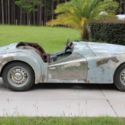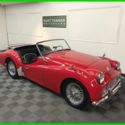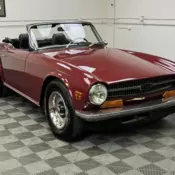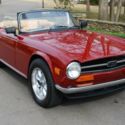Beautiful professional restoration, upgraded engine, Heritage Certificate, nice!
| Make: | Triumph |
| Model: | Other |
| SubModel: | TR4 |
| Type: | Convertible |
| Year: | 1965 |
| Mileage: | 25,677 |
| VIN: | CT27924L |
| Color: | Green |
| Cylinders: | 4 |
| Fuel: | Gasoline |
| Transmission: | Manual |
| Interior color: | Tan |
| Vehicle Title: | Clear |
| Item location: | Macedonia, Ohio, United States |
1965 Triumph Other Additional Info:
If the TR2 and TR3 put Triumph on the map as a legitimate sports car maker, it was the TR4 that made them viable for more than just the purists with string-backed driving gloves. Bigger, more civilized, and beautifully styled, this was a car that any car guy would lust after in the early 1960s. The fact that it remained eminently affordable and provided the kind of fun, tossable, easy-to-handle driving experience that made British sports cars so popular was merely icing on the cake. If you can’t afford a Jaguar or a big Healey, there’s a good argument to be made that the TR4 offers that same kind of experience for a fraction of the cost.
This gorgeous 1965 TR4 roadster was given a comprehensive frame-off restoration in 2010 and remains in virtually showroom condition today. The traditional combination of British Racing Green with tan hides and top makes for a stunning presentation that looks far more expensive than it is and will simply never go out of style. The bodywork was styled by the Italian firm Michelotti, and they did a simply masterful job of updating the Triumph look while keeping the same robust hardware underneath. Proportions are ideal, with a long hood and short deck, and the wonderfully styled front end neatly bridges the bug-eyed TR3 and it’s very 1950s look and the thoroughly modern but somewhat anonymous TR6 that would follow in the 70s. Regardless, it’s beautiful from any angle and you can see that the restoration was expensive, because every inch of sheetmetal is beautifully finished—probably better than new—and the glossy dark green paint shows off the results of many hours of laborious hand sanding to get everything flat and smooth. We’ve sold a number of early Triumphs, but the finish quality of this spectacular little car rivals the big E-Type Jaguars that cost four times as much. Kudos to the fellows who did the work, because they were craftsmen of the highest order.
Likewise, all the chrome and stainless trim was restored, refinished, or replaced. The beautiful body is accented by stainless strips between the panels, so you get a dashing accent along the crowns of the fenders. The chrome grille sparkles, the closely-fitted bumpers have deep reflections, and the chrome luggage rack out back adds a dash of practicality that’s welcome in a car that you’re going to want to drive often and far. Correct emblems, lenses, and handles were installed at the same time, so it looks very proper.
The lovely tan leather interior shows you what a few upgrades can do. Michelotti moved the dashboard forward and widened the cockpit four inches, which, along with the full-height doors and roll-up windows, made the TR4 a viable candidate for daily transportation. The beautiful bucket seats wear fresh seat covers that match the door panels and rear compartment, and there are correct carpets on the floor with matching bindings. All the lovely Jaeger instruments were rebuilt, so they show bright, crisp markings and shiny chrome bezels that add a classic look. The skinny banjo-style steering wheel is the lone throwback to the earlier cars, but it affords pinpoint control of the front wheels’ activities and keeps steering effort light, even at very low speeds. Everything works: the gauges, the heater, the lights, all of it, although you’ll find there is no radio here—I suspect that if you need one in your British sports car, you’re doing something wrong. The wooden veneer on the dash has just the right soft shine to impart the fact that it’s real wood, not plastic, and the switchgear all feels surprisingly substantial. Weather protection consists of a new tan top that stows in the trunk (the top “sticks” disappear behind a panel in the rear compartment) and a proper tonneau cover that’s the right way to drive your British sports car solo. There’s also a good-sized trunk with a correct fifth wire wheel and Michelin tire that looks to be original equipment. And no, you won’t find any rust in this TR, with the spare tire bay looking almost new.
The engine is a thoroughly reworked 2138 cc inline-4, a little bigger than Triumph’s TR3 engine but its fatter torque curve makes it a joy to drive in today’s traffic. There are a myriad of upgrades here, including a bit more compression from a set of forged aluminum pistons, a custom camshaft, ported head, and an aluminum flywheel that gives the engine razor-sharp reflexes. It inhales through twin Strombergs and the exhaust is handled by a tubular exhaust header and performance exhaust system with twin outlets in back. The modifications are subtle, but things like the chrome valve cover and air cleaners do add a bit of flash to the functional engine bay. There’s also a modern alternator making electricity, so you can banish thoughts of Lucas’s nighttime antics right now. The engine fires easily with a little choke and settles into a 1000 RPM idle without a lot of adjusting, and once it’s warmed up, you can throttle it down to about 750 RPM easily. The lightweight flywheel makes it feel lightning quick and the generous torque curve pulls the little roadster around without seeming to work very hard. And, of course, you get that wonderful baritone exhaust note, a brawny wail that’s all out of character for such a diminutive car.
As you’d expect with a restoration of this quality, the chassis has likewise been fully restored. Body-colored floors, rebuilt suspension and brakes, and that new exhaust system are all reassuring for the next owner who intends to use the car properly. This car spent the majority of its life in warm, dry Texas, so there are no signs of rust, botched repairs, or patch panels in the usual places, making this one of the cleanest Triumphs we’ve ever seen. The car is fitted with front disc brakes, a desirable upgrade, and the wire wheels were powdercoated gray instead of chromed, which many will agree is the right choice on a modest car like this. New 205/70/15 blackwall radials give it a broad-shouldered look and improve ride and handling to a significant degree.
Documentation includes a Heritage Certificate as well as extensive restoration photos and receipts. You will note on the Heritage Certificate that it was built in December 1963, shipped to the US as a 1964, but was sold in 1965 and is therefore titled as a 1965 model. This was common at the time, so no need to be alarmed.
You’ve probably not seen a TR4 this nice before—we sure haven’t. There are plenty of cheaper ones, and if you’re one of those guys who thinks that the British Sports Car experience should include being stranded by the side of the road at inopportune times and trying to figure out esoteric repair schematics in your garage, well, you should buy a cheap one. But if you simply want to drive, get in and go without a second thought, and have what is arguably the prettiest 2-seat convertible under $50,000 then you should give us a call right away. Cars this nice, price be damned, just don’t sit around very long.












